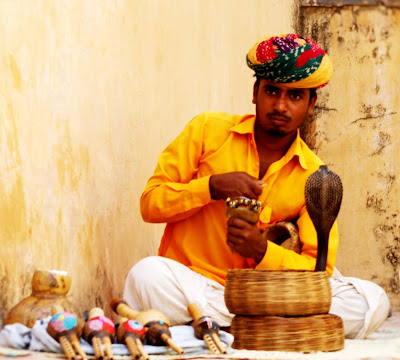 |
| Snake Charmers at Jaipur Palace |
As we were concluding our day tour to the Amer
Fort, Jaipur, we were quite astonished to see two
snake charmers (“Sapera”,
“Sapela”, “Sapuakela”) wearing colorful turbans having two bamboo baskets in
front and many “pungis” dotting the ragged piece of cloth they were sitting on.
I had not seen a snake charmer since decades and this was a miracle.
 |
| Snake Basket @ Padmasekharpur Odisha |
Childhood memories started fleeting by and I
remember the summer holidays when all cousins would gather at our grandmother’s
place. Back in the 80’s snake charmers in cities and towns were quite common
and we would wait eagerly to call them home at least once during the summer
break. The “Sapuakela” would come with
multiple baskets each having a separate species of snake and enchant us for an
hour or so and taking back with him a few Rupees. I vividly remember seeing the Cobra, Rat
Snake, India Python, Russel Viper and the Sand boa. The swaying moment of the “pungi”
and the Cobra would be in unison and we always thought that the snake was
responding to the sound. Little did we know those days that snakes are deaf and
they tend to follow the movement of the “pungi”. Years passed by and we would
follow a similar routine every summer, we grew up and routines changed. The
country went through a phase of urbanization, development and
environment/wildlife conservation and when I look back we lost touch with the “Snake Charmers of India”.
Back to present day, I was eager to relive the olden days and was excited what was in store. As one of the snake charmer lifted the hood of the basket, there arose the majestic Indian Cobra also known as spectacled cobra, Asian cobra or Binocellate cobra.
 |
| Snake Charmer with Cobra@Jaipur Palace |
At this point of time, the
conservationist in me decided to go on the back foot and allowed the child in
me savour the moments. While we failed to capture the moments on video, the following video one
by "Dustin Kerschtien"matches what we experienced.
Days passed by post the Jaipur trip and I
forgot about those beautiful memories, until the day when I heard Prime
Minister of India, Shri Narendra Modi addressing people at the Madison Square Garden(Sep
2014). "India was once known as the “land
of snake charmers”. Had it not been for Indian Americans, who have excelled in
various fields, that image would not have changed. During a foreign trip I was
asked whether India was still about “snake charmers”. I said, "Our ancestors
used to play with snakes, we play with mouse”.
It intrigued me again to revisit the
topic of Snake Charmers of India and I set out to understand what has happened
to Snake Charmers all over the country. India
has around 250+ species of snakes and alteast thousands of
people who have knowledge of this trade(snake charming) in different pockets of
the country. Over the past few decades many of them have taken up to alternate
professions/trades (like agriculture, govt jobs, begging etc.) after the passage
of the Wildlife Protection Act of 1972 which made Snake Charming illegal. Many
protests have happened in the country during this period however our need to lead on
the forefront of wildlife conservation deafens this noise.
The main question I have in mind "Is
this trade dying?" Definitely not is my thought and it should not be allowed to just cease one
day. The centuries of wisdom the “Saperas” have with them should be used and is
being probably being used at many places. With the lack of primary healthcare
in villages, the villagers are often depended on “Sapera’s” to treat snake
bites as they have access to traditional herbs & roots that may heal. On the other hand to help them generate
livelihoods the governments have legitimized Snake Charming in tourist places
like in Amer(Jaipur) Fort. More efforts are needed by the government, animal
conservation groups and citizens of India to help them generate livelihood.
Back to my research, I stumbled across an ethno-botanical study “From charmers to educators: Using indigenous
knowledge for conservation education“ conducted by “Bahar Dutt, Rachel Kaleta and
Vikram Hoshing”. The study concluded
beautifully as follows: “To conclude it would be easy to just let snake
charming come to an end in an era of globalization and mass communication. On
the other hand, a lot can be done to save the traditional skills of this
community caught between their past and modern conservation laws. The
employment of snake charmers as ‘barefoot conservation educators’ and the recognition
of their indigenous knowledge would not only protect their culture and identity
but also assist in the protection of thousands of snakes killed through
ignorance”.
As you are browsing through this extensive
study, I leave you with this beautiful dance form Kalbeliya from Rajasthan which is performed by nomadic
tribe who are snake charmers.
Contributed by Sandip Mishra
Photocredits (EnigmaticIndia team and Saumya Parida)



No comments:
Post a Comment